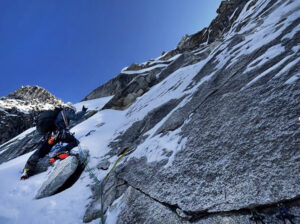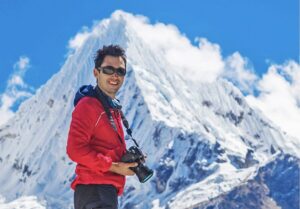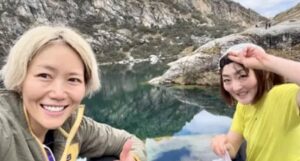The Second Seven Summits, the lesser-known and more difficult little brother of the Seven Summits, involves climbing the second-highest peak on each continent. In South America, this means climbing 6,893m Nevado Ojos del Salado. Ojos del Salado is the highest mountain in Chile and the highest volcano on Earth.
Location
Ojos del Salado lies in the Andes, on the border between Chile and Argentina. It is east of Atacama, and west of the Argentine province of Catamarca. It is the most famous mountain on the 80,000 sq km Atacama Plateau.
Most of the Atacama lies in Argentina. Only 15% nudges into Chile. The plateau is geographically different from Chile’s famous Atacama desert, although both are very dry.

Nevado Ojos del Salado, on the border between Chile and Argentina. Photo: Wikipedia
Still active
Geologically, the Andes are a young mountain range. They began to emerge approximately 100 million years ago. Earthquakes and volcanic eruptions frequently rock the Andes. The highest active volcano on earth measured from sea level, Ojos del Salado is a stratovolcano that was largely formed from the accumulation of lava flows and explosive volcanic material.
Ojos del Salado has been active since the Pleistocene and is still considered active today, though its last eruption took place 1,300 to 1,500 years ago. However, sulphuric emissions were observed in 1937 and 1956. More recently, in 1994, it produced an intermittent gray plume of water vapor and sulfurous gases.

The north face of Ojos del Salado. Photo: Guillermo Almaraz
The mountain
Ojos del Salado translates literally as eyes of water. “Salado” is actually a river, so the name of the mountain means spring at the headwaters of the Salado River.
Despite these aquatic references, the mountain’s climate is high desert. Day and night temperatures vary widely, with an average maximum of 18°C and an average minimum of -10°C. On the summit, the temperature can drop to -30°C with winds of 80kph.
The upper part of Ojos del Salado features a set of craters and elongated volcanic peaks. At the main summit, a high cone rises from an area spanning 70 sq km. The highest part of the volcano has three summits, one main and two secondary summits oriented east-west. The main summit measures 6,893m, the central one 6,752m, and the western one 6,721m.

A snow-covered Ojos del Salado. Photo: Arkaitz Ibarra
The main summit further breaks down into two rocky towers, separated by a gap 50m wide and 30m deep. The east tower, also called the Argentine summit, has a small metal pyramid at its highest point. The western tower, the so-called Chilean summit, is an isolated needle with a metal rod on top.
Although designated as Argentine or Chilean, the border between Chile and Argentina in fact passes through both.

The west tower (Chilean) from the east tower. Photo: Wikiwand
Height
Until 20 years ago, the exact height of Ojos del Salado was the subject of debate. Ojos del Salado was not included on any official maps until the 19th century, and its height was determined without exact measurements. It was estimated to be 6,100m, and this “measurement” stuck until the first expeditions and subsequent ascents. Ojos del Salado was pegged at 6,893m, although different heights persist to this day.
Early exploration
One of the most interesting characters to explore the Atacama was the German geographer, geologist, and climatologist Walther Penck. At the age of 24, Penck went to work in Argentina.

German geographer Walther Penck. Photo: Gerhard Penck Photo Archive
Between 1912 and 1914, Penck toured the Argentine-Chilean Plateau and wrote down all his adventures and observations in a series of small notebooks. Riding a horse, with basic equipment, he explored and mapped thousands of square kilometres.
Penck also climbed some 30 peaks in the Andes between 4,000m and 6,000m. He wrote numerous treatises, books, and scientific publications, including The Morphological Analysis and The Austral Edge of the Puna de Atacama. During his short life (he died at 35 from illness), Penck achieved much.

Walther Penck in his base camp on the Plateau. Photo: Gerhard Penck Photo Archive
Polish expeditions arrive in the Andes
A first Polish expedition to the Andes arrived in 1934. Its members managed to climb Cerro Mercedario, Alma Negra, Negro, La Mesa, and a glacier now called Glaciar de Los Polacos. Then in 1937, a second Polish expedition arrived in Argentina to explore, map, and climb.

Jan Alfred Szczepanski, Justin Tymon Wojsznis, Stefan Osiecki, and Witold Henryk Paryski. Photo: Cultura de Montana
The expedition, led by Justin Tymon Wojsznis, included doctor and meteorologist Witold Henryk Paryski, chronicler Jan Alfred Szczepanski, and Stefan Osiecki, in charge of logistics and organization. The group had brought one of Walther Penck’s books with them.
The approach march to the range took them eight days, and they spent two more weeks acclimatizing. On January 17, 1937, they began to ascend the Los Patos Volcano (6,239m), topping out to notch the first ascent the following day.
The first ascent of Nevado Ojos del Salado
After their ascent of Los Patos Volcano, the team then split into two. On February 26, 1937, Wojsznis and Szczepanski went to Nevado Ojos del Salado to climb the southwest flank. Despite heavy snow, Wojsznis and Szczepanski were able to set up a camp at 5,800m. From there, they advanced to Camp 2 at 6,400m next to a frozen lake. Above 6,400m, they set up one further camp. From here, they began their summit push.
On February 26, Wojsznis and Szczepanski reached the main summit on the east tower of Ojos del Salado. They left behind a can and some cards.

Approaching from the north. Photo: Cultura de Montana
The second and third ascents
After several failed attempts, Ojos del Salado was ascended for a second time 19 years later. Austrian Mathias Rebitsch climbed the northeast slope from Argentina, reaching the east tower on February 2, 1956. He found the can and cards that the Poles had left almost 20 years earlier.
Three days later, from the Chilean side, under the leadership of Rene Gajardo, another team ascended the volcano. They summited the western tower. Seeing no signs of previous climbers on the summit, they claimed the first ascent. Eventually, the Andean Club of Chile ruled that the first to crown Ojos del Salado was indeed the Polish expedition of 1937.

Mountaineers head up Ojos del Salado. Photo: Andescontact
Which tower is higher?
The western (Chilean) tower is marginally higher than the eastern (Argentine) tower. However, since the difference is less than one metre, the two towers are typically listed as the same height, thus validating both as the official summits of the volcano.

Jabi Txicon Narvaez on the summit of a windy Ojos del Salado. Photo: Arkaitz Ibarra
Difficulty
Nevado de Ojos del Salado is not technically very difficult. At the top, however, it is a bit more complicated and exposed than Aconcagua. Both mountains require good physical preparation and proper acclimatization.
However, you can reach as high as 5,900m by four-wheel-drive on Ojos del Salado. This makes things substantially easier, if you wish. Aconcagua is only accessible by car to 3,000m.

A 4×4 approaches Ojos del Salado. Photo: Diario del Viajero
The route from the Argentine side is far less frequented than the route from Chile. Only about one of every 16 ascents is from the Argentine side. The rest go up the Chilean side.
The north face route involves rough a 1,500m elevation gain. It is 6.7km long and passes through the Atacama Refuge, the Tejos Refuge, and then on to the summit. This route, considered the normal one from the Chilean side, was climbed for the first time in 1979.
Other routes
You can also climb the northeast route, first climbed in 1973 by Michael Kelsey.
The west face route reaches the east tower from a base camp of almost 5,000m. This route is about 11km long and was climbed for the first time by two Japanese in December 1970.
Mathias Rebitsch’s 1956 southeast route is very arduous, with a 48km approach and an ascent almost 11km long.
The Warsaw route goes along the east face of the volcano to the eastern tower. It was first climbed in 2009.
The south route leads to the east tower, includes a drop of almost 2,000m, and is more than 25km long. It was first ascended in 2010.
The Polish route from 1937 goes along the southwest face for 20km, starting the ascent from the base camp at 4,640m.
The highest lake in the world
Nevado de Ojos del Salado also features the highest lake in the world. Located at 6,400m on the southeast face, it is about 100m in diameter and 10m deep.

The Ojos del Salado Pool is the highest lake in the world. Photo: Istock Reisegraf
Erno Tosoki of Hungary went scuba diving here on February 21, 2016. To accomplish this, he had to carry 100kg of gear up the mountain with partner Patricia Nagy. Tosoki spent five years preparing for this challenge and had attempted it twice previously.
Tosoki dove for 10 minutes. Then a storm rolled in, with lots of wind and fog. The two-member team had to flee down the mountain. Their obscure record will be hard to break until someone finds a higher lake somewhere else.

Erno Tosoki dives in the highest lake in the world. Photo: Dive Magazine






